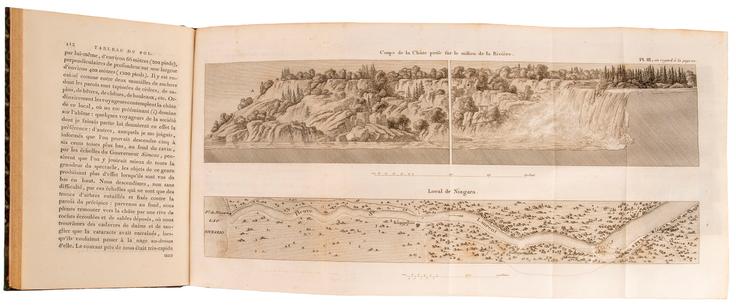CONSTANTIN-FRANÇOIS CHASSEBOEUF, COMTE DE VOLNEY (1757 - 1820) 1. Tableau du climat et du sol des Etats-Unis d’Amerique. Suivi d’éclaircissemens sur la Floride, sur la colonie Française au Scioto, sur quelques colonies canadiennes et sur les sauvages 2. Law of Nature, or Principles of Morality, Deduced from the Physical Constitution of Mankind and the Universe
Лот 904
1 5002 000
1) (Table of the climate and soil of the United States of Ame-rica. Followed by clarifications on Florida, on the French colony in Scioto, on some Canadian colonies and on the savages)
Paris: Courcier and Dentu, ‘An XII. - 1803’
8vo (197 x 124mm). Contemporary French green calf over marbled boards, spines gilt in compartments, lettered direct-ly in 2, others decorated in blind, decorative gilt rolls at foot of spine, patterned endpapers, all edges speckled, blue silk markers; pp. I: [4 (half-title, publisher’s advertisement on verso, title, verso blank)], xvi, 300; II: [4 (half-title, errata on verso, title, verso blank)], [301]-534, [2 (errata and ‘Avis au lecteur’, ‘Avis au relieur’); 2 engraved folding plates and 2 folding engraved maps by E. Collin; extremities lightly rubbed and bumped, first 4 ll. ff vol. II lightly browned, a few light marks, maps slightly creased, one with skilfully-repaired tear, nonetheless a very fresh and attractive set in a contemporary binding; provenance: Stuart Wells Jack-son (1875-1957, etched bookplate by Bernhardt Wall sig-ned in the plate ‘Wall ‘24’ on upper pastedown of vol. I).
First edition, Sabin’s issue A. Tableau du climat et du sol des Etats-Unis d’Amerique is based upon a three-year expedition throughout North America undertaken by the French philosopher, politician, historian and traveller Vol-ney. Although the work was originally intended to be com-posed of two parts - the present text and a second part on the political and moral characteristics of the United States - Volney eventually decided to restrict himself to the subjects covered in these volumes, and the resulting work is one of the earliest accounts of the geology and climatology of the United States. ‘Volney’s book [however] is not a travel book in which scientific description and analysis are included as part of a travel narrative, but rather it is a book in which or-ganized description and analysis is the main object’ (White’s introduction to the 1968 Hafner edition of the Tableau, p. ix).
This set is particularly notable for its provenance: it was pre-viously in the library of the distinguished American biblio-phile Stuart W. Jackson, who was particularly interested in American history and Franco-American relations, which re-sulted in the formation of an important Lafayette collection and the publication of his La Fayette: A Bibliography (New York: 1930) and various articles. The Lafayette collection was gifted to Yale University after Jackson’s death (the university had previously received his Lincoln collection), and described by Whitfield J. Bell, jr. as ‘a great collection, probably the largest and finest on Lafayette ever assembled by a private person’ (‘The Stuart W. Jackson Lafayette Collection’ in The Yale University Library Gazette (vol. 33, No. 2 (October 1958), p. 49). As Bell comments, Jackson was ‘a warm friend of France and promoter of Franco-American philanthropies and cultural exchange’ (loc. cit.), serving as President of the American Friends of Lafayette and a Trustee of the Yale Li-brary Associates, and in 1954 he was appointed Chevalier of the Legion of Honor. The first volume bears Jackson’s etched bookplate, designed for him by his friend, the distinguished American engraver, artist, printer, and historian of the Ameri-can West, Bernhardt Wall (1872-1956), who also designed a special bookplate for Jackson’s Lincoln collection and dedica-ted his edition of Lincoln’s Gettysburg Speech (Sierra Madre, CA: 1946) to Jackson.
2) London: 'Philadelphia Printed ... Reprinted for D. Steel', 1796.
12mo (131 x 77mm). Contemporary vellum, gilt-ruled boards, spine ruled in gilt in compartments, gilt leather lettering-piece, marbled endpapers, silk marker; pp. [i]-x, [11]-171, [1 (blank)]; stipple-engraved portrait frontispiece by Ridley, wood-engraved tailpieces; lettering-piece very slightly chipped, some marking, boards slightly warped, slight marginal worming in first and last 2 quires, otherwise a very good copy.
This work was first published in French under the title La loi naturelle, ou Catéchisme du citoyen français (Paris: 1793). Four English editions were published in London in 1796: the present edition, based on the Philadelphia edition issued by F. & R. Bailey in 1796, and a 58-page octavo edition issued by D.I. Eaton, which reached a third edition in the same year (a further English edition was also published in Dublin in 1796). Written in the form of a cathecism, this beautifully printed little book is a complete course of ethics, based on rationalism and logic. The unknown editor in the preface points out, that the style of composition is similar to that of Franklin (Volney actually visited the United States from 1795 to 1798) and extols confidence in the progress of the enlightenment: 'The period is arrived, when men should be taught, by the conviction of their own senses, that the radical source of their melioration and moral improvement is to be looked for, in their organization, in the direction and interest of their passions, and in the very constituent elements of their existence' (p. V). This edition is uncommon; ESTC only locates two copies in the UK, and five outside.





